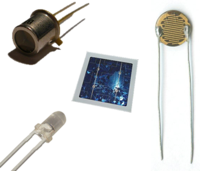
Photo from wikipedia
Optical chemical imaging has established itself as a valuable technique for visualizing analyte distributions in 2D, notably in medical, biological, and environmental applications. In particular for image acquisitions on small… Click to show full abstract
Optical chemical imaging has established itself as a valuable technique for visualizing analyte distributions in 2D, notably in medical, biological, and environmental applications. In particular for image acquisitions on small scales between few millimeter to the micrometer range, as well as in heterogeneous samples with steep analyte gradients, image resolution is essential. When individual pixels are inspected, however, image noise becomes a metric as relevant as image accuracy and precision, and denoising filters are applied to preserve relevant information. While denoising filters smooth the image noise, they can also lead to a loss of spatial resolution and thus to a loss of relevant information about analyte distributions. To investigate the trade-off between image resolution and noise reduction for information preservation, we studied the impact of random camera noise and noise due to incorrect camera settings on oxygen optodes using the ratiometric imaging technique. First, we estimated the noise amplification across the calibration process using a Monte Carlo simulation for nonlinear fit models. We demonstrated how initially marginal random camera noise results in a significant standard deviation (SD) for oxygen concentration of up to 2.73% air under anoxic conditions, although the measurement was conducted under ideal conditions and over 270 thousand sample pixels were considered during calibration. Second, we studied the effect of the Gaussian denoising filter on a steep oxygen gradient and investigated the impact when the smoothing filter is applied during data processing. Finally, we demonstrated the effectiveness of a Savitzky-Golay filter compared to the well-established Gaussian filter.
Journal Title: ACS Omega
Year Published: 2022
Link to full text (if available)
Share on Social Media: Sign Up to like & get
recommendations!